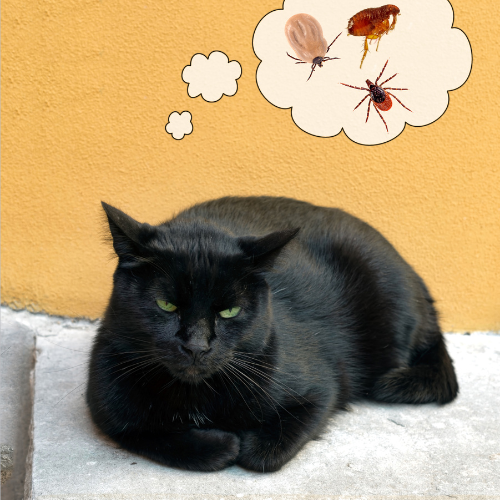
21 Feb Flea and Tick Control for Cats
Feline Pest Protection in Warm Climates
For cat lovers in South Florida, keeping your furry friends safe from fleas and ticks is a top priority. These tiny pests can cause discomfort, itching, and even transmit diseases to your beloved pets. In this comprehensive guide, we’ll explore effective strategies for flea and tick control, ensuring your cats remain happy and healthy.
In addition to causing physical discomfort, fleas and ticks can also lead to emotional stress for both cats and their owners. Watching your feline friend suffer from constant itching and scratching can be heartbreaking. That’s why it’s important to take proactive measures to prevent these pests from making your cat’s life miserable.
Moreover, living in South Florida’s warm climate means that fleas and ticks are active year-round. This makes ongoing prevention even more crucial to keep your cats protected. By following the tips in this guide, you can create a safe and comfortable environment for your feline friends.
Flea and Tick Dangers for Cats and Humans
Fleas and ticks are more than just a nuisance; they can pose serious health risks to your cats. Fleas can lead to allergic reactions, anemia, and even tapeworm infections, while ticks can transmit diseases like Lyme disease and Rocky Mountain spotted fever.
The life cycle of fleas and ticks makes them challenging to eliminate. Fleas can lay up to 50 eggs a day, and ticks can survive for long periods without a host. Understanding their behavior is crucial for effective control and prevention.
It’s important to note that not all cats show obvious signs of flea or tick infestations. Some may suffer in silence, making it essential for cat owners to be vigilant in checking their pets regularly. Early detection can prevent the situation from escalating and causing more severe health issues.
Additionally, the presence of fleas and ticks in your home can also pose risks to human health. These pests can bite humans, leading to irritation and, in some cases, allergic reactions. Keeping your cats free from fleas and ticks is not only beneficial for their health but also for the well-being of your entire household.
Creating a Safe Space
Regular grooming is essential for keeping fleas and ticks at bay. Brushing your cat’s fur helps remove any pests and their eggs. During grooming sessions, check for signs of infestation, such as small black specks (flea dirt) or tiny bumps (ticks).
Bathing your cat with a flea and tick shampoo can also help control these pests. However, it’s important to use products specifically designed for cats, as some ingredients can be harmful to them.
Maintaining a clean environment is key to preventing flea and tick infestations. Vacuum your home regularly, especially in areas where your cat spends a lot of time. Wash your cat’s bedding and toys frequently to eliminate any hidden pests.
Consider using pet-safe environmental treatments, such as sprays or powders, to reduce flea and tick populations in your home and yard. Be sure to follow the instructions carefully to avoid any risks to your pets.
Choosing the right bedding and accessories for your cat can also help prevent fleas and ticks. Opt for materials that are easy to wash and less likely to harbor pests. Regularly washing your cat’s bedding in hot water can kill any lingering fleas or ticks.
Combating Severe Flea Infestations
There are various flea and tick prevention products available for cats, including topical treatments and oral medications. Topical treatments, such as spot-on solutions, are applied directly to your cat’s skin and provide long-lasting protection.
Oral medications are another option for flea and tick control. These are usually given once a month and can be more convenient for some cat owners. It’s important to consult your veterinarian before starting any new treatment to ensure it’s safe for your cat.
For those seeking natural flea and tick control options, there are several alternatives. Herbal remedies, such as neem oil or diatomaceous earth, can be effective in repelling pests. However, it’s crucial to research these options thoroughly and consult with your vet, as some natural remedies may not be safe for all cats.
Regular check-ups with your veterinarian are vital for keeping your cat protected from fleas and ticks. Your vet can recommend the most suitable prevention products based on your cat’s health and lifestyle.
If you’re dealing with a severe infestation, professional pest control services may be necessary. These experts can provide targeted treatments to eliminate fleas and ticks from your home and prevent future outbreaks.
Conclusion
In conclusion, flea and tick control is an essential aspect of pet care, especially in warm climates like South Florida. By implementing regular grooming, maintaining a clean environment, and choosing the right prevention products, the risk of infestations can be significantly reduced. It is crucial for the comfort and health of both your feline friends and your family.
Moreover, understanding the behavior and life cycle of these pests is key to effective control and prevention. Early detection and prompt action are vital in preventing the spread of infestations and protecting your cats from potential health risks.
It’s also important to consult with your veterinarian for personalized advice and to ensure the safety of any treatments used. Professional pest control services may be necessary for severe infestations, providing peace of mind and a long-term solution to keeping your home and pets pest-free.
Remember, a proactive approach to flea and tick control will help ensure that your cats remain happy, healthy, and comfortable, allowing you to enjoy the companionship of your feline friends without the worry of pests.


No Comments